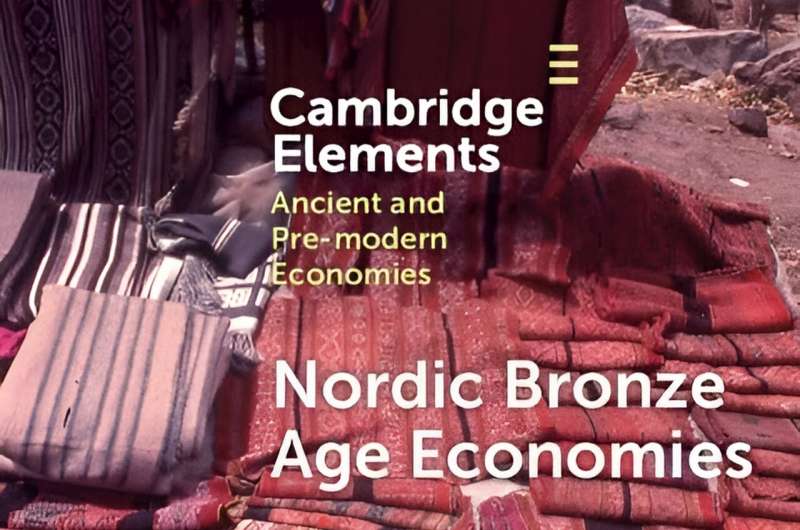This article has been reviewed according to Science X's editorial process and policies. Editors have highlighted the following attributes while ensuring the content's credibility:
fact-checked
trusted source
proofread
Significant differences among nordic regions during the Bronze Age

The Scandinavian Bronze Age—despite a unifying material culture—was complex with constantly changing networks involving both competitors and collaborators. In a new book by archaeologists from the University of Gothenburg and the University of Oslo, the Bronze Age in the north is explored through a broad spectrum of topics such as domestic and political economies, trade, warfare, alliance-building, and maritime technology.
The book "Nordic Bronze Age Economies" is being published in the scientific book series Cambridge Elements and highlights the diversity of local societies that flourished during the Bronze Age in Scandinavia, spanning from 1800 to 500 BCE. It is written by archaeologists Christian Horn, Johan Ling, and Magnus Artursson from the University of Gothenburg, along with Knut Ivar Austvoll from the University of Oslo.
"The book will serve as a new textbook for beginner students and interested amateurs, as well as professional archaeologists seeking an overview of Scandinavia during that time," says Christian Horn, who led one of the major research projects that resulted in the book.
The research is based on two research projects: Modelling Bronze Age Societies, led by Christian Horn, and Maritime Encounters, led by Johan Ling.
Different types of economies
The social structure was influenced by the subsistence economies of the societies; whether the economy was based on agriculture and animal husbandry, seafaring, production of metal wealth, trade—or on raids and warfare.
There are abundant archaeological remains from the Bronze Age to study these aspects.
"It was a very impressive material culture, and a lot has been found in graves. Many of the artifacts look similar across the Nordic region, but our focus has been on finding regional differences."
"The goal has been to break up the grand narrative. We can see that the cultural heritage is very similar, but there are differences between, for example, Denmark, Scania, Bohuslän, and Norwegian regions. Research has shown that the different societies were constantly in contact with each other. People were also very mobile and traveled by boat to England and Iberia," says Christian Horn.
Farming and fishing
So how did the Scandinavian Bronze Age economies differ between regions?
In Denmark, there were communities with large farms focusing on agriculture and animal husbandry, while the communities along the coasts of Sweden and Norway focused on the maritime world. There, they fished and built boats, with less agriculture or animal husbandry.
"In the maritime communities, there was a need to import more food, and social organization was more collective," says Christian Horn.
In large farming communities, on the other hand, there was a more hierarchical organization, with few at the top.
Although the material culture was very similar, there were also differences. Swords, for example, looked the same across Scandinavia, and similar types of graves were found—but while swords were commonly placed in burials in Denmark and Skåne, this was very rare in Bohuslän and Norway. In addition, the stone cairn graves in Bohuslän and Norway were also not covered with soil like the burial mounds in the southern regions.
Swords were also something that differed when it came to rock carvings. Researchers have discovered that some rock carvings were updated throughout the Bronze Age, for example, that a sword was added to warriors with shields.
Trade and warfare
The aim of the book was to present a comprehensive picture of the Bronze Age, showing how different societies worked together but also engaged in wars and conflicts, where those who could not participate in regular trade became more like pirates.
"It is common for archaeology to focus on either trade or warfare, but by looking at all aspects, we can better understand how all local societies functioned together," says Christian Horn.
An example of how regions must have cooperated can be demonstrated by modeling of how much bronze the different societies had in a year. The research behind the book is based on so-called big data, with databases covering more than 30,000 sites with bronze objects and 6,000 carvings of human figures and their possessions.
All of the authors are archaeologists, but other theories have been incorporated, such as economic and sociological theories. In addition, the results were extensively discussed with anthropologists and ethnologists.
More information: Nordic Bronze Age Economies: www.cambridge.org/core/element … 93CD53985D77844780D5
Provided by University of Gothenburg




















